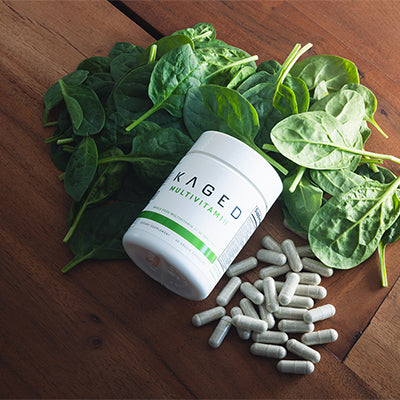How to Calculate Your Calories in 3 Minutes to Help Lose Weight and Build Muscle
Understanding your calorie needs is a fundamental first step if your goal is to lose fat, build muscle, and improve your physique.
Without understanding your daily calorie needs, you simply have no way of knowing how much you need to eat.
You see, whether you’re trying to shed fat or build muscle (or both at the same time), dropping calories too much, or raising them aggressively is a recipe to either gain fat while you bulk, or lose muscle while you cut.
As any good coach will tell you, a steady pace is the way towards consistent, lasting body composition changes. After all, you don’t want to gain muscle, only to notice you’ve added some serious body fat. Nor do you want to “crash diet,” lose the weight, only to add it back on later.
Calculating Your Calories Helps You Set The Right Course Towards Fat Loss and Muscle Gain.
If you want rapid transformation, you can’t leave any stones unturned. You have to dot your T’s and cross your I’s.
In this article, we go over a simple framework and a more advanced framework to accurately calculate your calorie needs in just a few minutes.
A Simple Step-By-Step Guide to Know Your Calorie Needs
Luckily, knowing your calorie needs isn’t rocket science. All you need are a few simple frameworks, and a 7th grade math level.
Once you’ve established your baseline, you can then consider daily changes and tweaks based around your goal, which we will discuss below.
Step #1: Determine Your Maintenance Calorie Intake
Before you know how much you should eat to burn fat or build muscle, you need an estimate of what you just burn naturally, without exercising. While these are estimates, they’re a great starting place.
12 – 14 calories per pound for normal and healthy individuals with a sedentary lifestyle doing little to no exercise.
14 – 16 calories per pound for those that exercise moderately 3 – 5 times a week with relatively active lifestyles.
16 – 18 calories per pound for those involved in vigorous exercise and physically demanding jobs.
18.5 – 22 calories per pound for those involved in heavy training (for example 15 or more hours per week).
22 or more calories per pound for those involved in extreme training (for example 20 or more hours a week).
For example, if you pick 15 and multiply it by 200LB your maintenance calorie intake is 3000 calories.
Step #2: Add or Subtract From This Depending on Your Goals
For weight gain: Add 300 calories or 10-15% to the above calculation.
For weight loss: Subtract 600 calories or 25% from the above calculation
This formula is purely based on bodyweight and not lean muscle tissue. While it will be accurate for those who are a healthy bodyweight or fairly lean (around 15% body fat), it will be less accurate if your body fat is over 20 or 25%.
If you have a higher body fat percentage, then subtract 10 or 20LBs from your weight before making the calculations.
That’s it. Truly, this is all you need to start. From here, you can determine how much you need per meal, and can begin your meal planning.
Here’s an option that’s a bit more complicated, but will give you a more accurate measurement.
The ‘BMR’ Advanced Calorie Calculation Method
For the more advanced, we can get more accurate.
Step #1: Determine Your Basal Metabolic Rate
Your BMR is the amount of calories you would burn if you were completely inactive. It’s your base of metabolic activity.
You might need a calculator for this. To determine your BMR, follow this formula:
Men: BMR = [4.53 x weight in pounds] + [15.88 x height in inches] – [4.92 x age in years] + 5
Women: BMR = [4.53 x weight in pounds] + [15.88 x height in inches] – [4.92 x age in years] – 16
BMR Manual Steps
Step 1: Calculate 4.53 x weight in pounds = ………….
Step 2: Calculate 15.88 x height in inches = ………….
Step 3: Add the 2 numbers you’ve calculated so far together = …………
Step 4: Calculate 4.92 x age in years = …………
Step 5: Take the number obtained in step 4 away from the number obtained in
step 3 = ………
Step 6: Add 5 for males or take away 16 for females from this new number obtained in step 5.
Now you have this number, continue onto the next step.
Step #2: Factor in The Calories You Burn Through Activity
Multiply your BMR by a number between 1.2 and 2.2 based on these factors (
1.2 – Sedentary):
1.3 – 1.4 – Lightly Active (If you have light daily activity and do light exercise 1-3 days a week)
1.5 – 1.6 – Moderately Active (If you have reasonable daily activity and do moderate exercise 3-5 days a week)
1.7 – 1.8 – Very Active (If you have a physically demanding lifestyle and do hard exercise 6-7 days a week)
1.9 – 2.2 – Extremely Active (If you are an athlete in endurance training or have an extremely physical job with long hours and train 3+ hours per day)
Step #3: Add or Subtract Based on Your Goals
Now that you have your number, you can adjust it based on your goals.
For weight gain: Add 300 calories or 10-15% to the above calculation.
For weight loss: Subtract 600 calories or 25% from the above calculation
While this method based on BMR may seem confusing at first, it will provide you with a more accurate and tailored calorie guide.
When and How to Make Adjustments to Your Calories
One of the most important parts of tracking calories, or even simply tracking your diet and macros, is to make constant changes based on feedback.
Most people miss out on this vitally important point: they start a new diet plan and then just keep it the same, hoping results will magically appear.
None of us get everything right the first time. Especially if you’re a beginner, don’t be surprised if your calculations are perfect at first.
Your numbers may need calibration. Treat these measurements as baseline measures, which you will then tailor and adjust as needed.
The 10% Rule
In order to calibrate, make 10% increments in either direction every 2-4 weeks.
By making 10% changes you will not over- or under-shoot, it will also allow you to fine-tune your own needs for future diets.
All of these adjustments depend on your progress. If you’re trying to lose weight and it’s very slow, then drop calories by 10%. In contrast, if you are trying to gain weight and it’s very slow, you may wish to increase calories by 10%.
Along with these adjustments, the only other consideration is changes to your training regime. If, all of a sudden, you were to switch from a high volume bodybuilding-style workout, to a lower volume strength routine you must further tailor your calorie needs up or down.
Remember, although calories are vitally important, they do not cover all aspects of your diet. Food quality, food timing, and macronutrient breakdown all matter.
If you’re looking for a complete diet plan, including an approved list of foods and training plan that’s detailed down to every last rep, then we have you covered.
We have tons of programs for free right here on Kaged.com. Our brand-new, 2023 program Project Resolution is a 7-week program designed to help you shed fat and keep it off by retraining your habits.



























